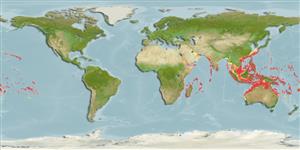Classification / Names
Common names from other countries
Main reference
Size / Weight / Age
Max length : 248 cm FL male/unsexed; (Ref. 40637); common length : 190 cm NG male/unsexed; (Ref. 9710); max. published weight: 131.0 kg (Ref. 168)
Environment
Marine; reef-associated; oceanodromous (Ref. 51243); depth range 10 - 250 m (Ref. 86942)
Climate / Range
Tropical; 20°C - 28°C (Ref. 5313), preferred 28°C (Ref. 107945); 31°N - 30°S, 32°E - 130°W (Ref. 168)
Distribution
Short description
Dorsal
spines
(total): 13 - 15;
Dorsal
soft rays
(total): 12-14;
Anal
spines: 0;
Anal
soft rays: 12 - 13;
Vertebrae: 38. Mouth fairly large, upper jaw reaching to middle of eye. Laminae of olfactory rosette 48 to 56. Interpelvic process large and single. Lateral line strongly undulating. Body naked posterior to corselet. Swim bladder large, spleen visible in ventral view on the right side of the body. The back and upper sides brilliant blue-black, lower sides and belly silvery; no lines, spots or other markings on the body.
IUCN Red List Status (Ref. 115185)
Threat to humans
Reports of ciguatera poisoning (Ref. 168)
Human uses
Fisheries: minor commercial; gamefish: yes
More information
ReferencesAquacultureAquaculture profileStrainsGeneticsAllele frequenciesHeritabilityDiseasesProcessingMass conversion
Tools
Special reports
Download XML
Internet sources
Estimates of some properties based on models
Phylogenetic diversity index
PD50 = 1.0000 many relatives (e.g. carps) 0.5 - 2.0 few relatives (e.g. lungfishes)
Trophic Level
4.5 ±0.75 se; Based on food items.
Resilience
Low, minimum population doubling time 4.5 - 14 years (Assuming tmax>10)
Vulnerability
High to very high vulnerability (73 of 100)
Price category
